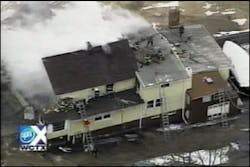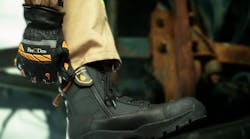I was a firefighter with the City of New Haven, CT, from 1987 to 2004. I had been a captain since 1998 and was assigned to Engine Company 17 on the day of this fire.
At 2:32 P.M. on Jan. 14, 2004, a 911 call was received reporting a house fire at 14 Cove St. Responding on the box alarm were three engine companies, a heavy rescue squad, a paramedic ambulance, a ladder truck company and a battalion chief. The following is an account of what happened to me at this fire. It taught me the price of complacency at a “routine” fire.
2:34 – Engine 5, the second-due pump, reported being involved in a collision one block from its station and was unable to respond. A cover company was promptly dispatched. Engine 17 moved up and became second due.
2:35 – Engine 17 radioed Truck 3 to take an alternate route as a swing bridge was opening for boat traffic. Truck 3’s response was delayed further by another bridge that had been closed to traffic for over a year. With both bridges being impassable, Truck 3 was forced to take a circuitous route that brought the unit to another bridge on which the gates were closing as the company approached. The bridge operator saw the truck responding and lifted the gates.
2:36 – Engine 16 arrived on scene and reported a working fire in a two-story wood structure. The officer initiated a hydrant-to-the-fire lay using two parallel three-inch lines. While approaching the house, the lieutenant observed heavy fire issuing from one window on side 2. Positioning in front of the house, a 1¾-inch, 250-foot pre-connected handline was stretched in the front door through the porch and into the first-floor apartment. Water was initially supplied from a 1,000-gallon booster tank. The Engine 16 crew entered the house on the first floor and encountered heavy, dark smoke and high heat. As the firefighters advanced, fire was extinguished, but the seat remained elusive.
The two-family house, 67 feet long by 28 feet wide, was built in 1875 using the balloon-frame method. Originally a summer cottage, it was divided into a two-family house with a portion used as storage for a small marina on the property. A rear exterior staircase was removed during an earlier renovation. All that remained was one interior stairway to the second-floor apartment. There was no direct exposure problem as the houses were a good distance apart. The temperature was 10 degrees and with the wind off the water the wind chill was minus 7 degrees. The wind was gusting toward the southeast, directly off the water and toward the house.
2:41 – Engine 17 arrived on scene. Heavy smoke could be seen coming primarily from the first floor with fire coming out of two windows on side 2.
Engine 17 was positioned to lay away from the fire, if needed. As I passed Engine 16, no problems were noted with the pump. I made contact with the occupant of the second-floor apartment and asked if everyone was out of the house. He appeared stunned and told me he couldn’t say for sure, but he knew his dog was still in there. At the same time, the pipe man stretched the secondary pre-connected 1¾-inch line to the front door. We made our way into the enclosed front porch. At the doorway to the first-floor apartment we made verbal contact with the crew of Engine 16. I was told that they were “hitting it.”
We found a moderate smoke condition in the enclosed front porch. We donned our SCBA (self-contained breathing apparatus) masks and stretched our line to the top of the stairs. The heat at the top of the stairs was unremarkable and, in fact, we were able to stand with no difficulty. The smoke was thick and at knee level. Keeping with our department procedures, we stretched the second line into the floor above the fire. No fire was initially found on the second floor, just smoke and a little heat.
2:43 – The third-due company, Squad 1, was ordered to assume the duties of opening the roof due to the ladder company’s delay. As we advanced the now-fully charged line into the second floor, searching for victims was our primary concern. As we moved in, windows were taken out to ease the smoke condition. We had made our way from the front of the apartment to the rear 3-4 corner, opening windows as we went along. At about this time, I noticed a marked increase in the temperature. The floor heated up dramatically. Unknown to us at the time, a flashover was occurring on the first floor. Fire pushed up the stairs and in our direction.
2:48 – A second alarm was requested by the battalion chief and he ordered Engine 16 and Engine 17 to start backing out. Two pumps, one tower, a deputy chief and various support staff responded.
It was then I noticed fire starting to roll across the ceiling from the area of the stairs. I called to the pipe man and told him to start knocking it down. The only reply that I remember hearing was that the line “went limp.” We were only a couple of feet from each other. Another, more urgent transmission from the battalion chief was heard, ordering us to back out. With little or no water and the amount of fire increasing, I did not have to be convinced to leave.
I called out to the pipe man, but did not get a reply. Fire was consuming most of the room and the visibility was zero. We were only a few feet apart when we lost contact. I called out again and got no answer back.
Downstairs on the first floor, the crew of Engine 16 (a lieutenant and two firefighters) also experienced a loss of water pressure. Crews on the outside were unable to enter because of the quickly expanding volume of fire. Engine 16’s crew was surrounded on all sides by fire and was urged to exit as quickly as possible through their only means of egress, a window on side 4 where the ground slopes and the bottom of the window was about eight feet off the ground. Unaware of just how bad it was getting, they needed convincing to exit via this window.
Outside, it became apparent that there was a water supply problem. When switching from the booster tank to the supply lines from the hydrant, the pressure dropped. While the pump operator began to troubleshoot the situation, two 1¾-inch lines going into the house started to burn through at the front porch.
As I searched for my missing partner, conditions became completely untenable. My overriding thought was that I just lost him. I was unable to find him or the line. Fire banked down almost to the floor. I came to a window on side 2 that had been opened up and stuck my head out to look for help. My helmet fell off and I couldn’t find it. While my head was out of the window, fire blasted out of the first-floor window below and at the same time fire rolled over my back and over my neck and head. This drove me back down to the floor inside. I was not wearing a hood. They weren’t department issue at the time of this fire.
I made a quick circle around the small apartment, finding no relief anywhere. No windows could even be seen at this time. I may have been roughly in the center of the room when my low-air warning sounded. I radioed rather ungracefully that I was trapped and wanted out. My message was repeated back to the battalion chief by our dispatchers. I heard the battalion chief telling me to get to a window on side 4. I was unable to reply. I did make my way to side 4 just as my SCBA completely ran out. I was not able to see any windows. I then removed my mask and curled into the fetal position with my lips to the floor.
In the meantime, since he was unable to make contact with me, the pipe man found a window, broke it with his helmet and jumped out head first, landing on the first-floor porch roof instead of the pavement two stories below. Immediately regaining composure, he summoned help from below and repeatedly asked if I was outside. When it became apparent that I was not, ladders were raised to the porch roof and crews joined him. Still without water, they prepared to make an attempt to enter. My partner kicked open the bottom sash of a window in preparation for an attempted rescue.
2:51 – Inside, I heard glass break above me multiple times as he kicked from outside. I was able to raise my gloved hand to the level of the window. It was at that time my partner saw the reflective stripe through the smoke and flames and without hesitation grabbed it and pulled. Without thought of the oppressive heat, I mustered enough will to lift my body off the floor. Firefighters then pulled me out to the relative safety of the porch roof.
Before I had completely made it out of the window, my mind was still on my partner that I still thought was missing. Repeatedly, I called his name, not fully realizing that it was him that was pulling me out. Finally, he got down and looked me in the eye and said that he was all right. I then laid my head on the roof, totally exhausted. When I heard that I would be carried down in a stokes basket, I rallied and climbed down a ladder with assistance.
Shortly after that, a positive water supply was re-established and a defensive attack was eventually changed to offensive when conditions improved.
4:15 – The deputy chief declared the fire “under control.”
The structure was deemed a hazard by a city building official. All investigative personnel were ordered out for their own safety. The house sustained major structural damage and was demolished by 10:30 that night.
Two weeks later, when weather conditions permitted, the hydrants in the area were checked. The first hydrant used flowed 260 gpm. The lay of two three-inch supply lines from the hydrant to Engine 16 was 400 feet downhill. This, combined with the flow from the two 250-foot 1¾-inch handlines, made it apparent that the primary water supply was woefully inadequate at the time of the fire. It was determined by the local water authority that the curb valve under the street supplying this hydrant was almost completely shut off. After opening the valve 10 additional turns, the hydrant was checked again and it then was flowing 2,241 gpm.
I sustained first-, second- and third-degree burns to my neck, head and face. My carbon monoxide levels were elevated as well, but I did not require hyperbaric treatment. I spent one night in the hospital. A week later, I returned to the hospital so that a surgeon could repair the third-degree burn on the back of my neck.
The cause and origin of the fire remain undetermined. While we were responding in Engine 17, white smoke could be seen billowing in the distance. Normally, this means that somebody is getting water on the seat of the fire. That’s what I always was taught. However, when the temperature is below 20 degrees Fahrenheit, smoke turns white. This lulled many of us into a false sense of security. When sizing up in front of the house, it appeared to be a “routine” fire – go in, squirt some water, pull some ceilings and leave. This couldn’t have been further from the truth. After careful analysis of this incident, I have identified some personal room for improvement. I failed to relay that we had lost pressure and that I had become separated from my pipe man. My “Mayday” was delayed until I was in a flat-out panic. It could have been done sooner, when I was more able to communicate the conditions and my location. My SCBA had an integral PASS (personal alert safety system) device, but I failed to activate the distress alarm. I was moving around so much that it never went off automatically.
Shortly after the fire, the department ordered protective hoods for everyone and mandated we use them. Previous to this fire, I was under the delusion that they were not needed. After all, I could sense changes in temperature better and seek refuge if it got to hot. There was no refuge immediately available to me, so I got burned. Get used to wearing your hoods. I am convinced that my burns would have been less severe or non-existent if I had worn a hood.
Much attention seems to be paid to our rescue of others. We should place more emphasis on self rescue. Never fall into complacency about “routine” fires. These are the ones that are killing firefighters.
Much analysis and many observations have been made about this fire. While I am sure the readers will no doubt pull it apart, as they should, sometimes the odds are just against us. A long list of problems occurred, and were noted, but in the end I am grateful to have survived the ordeal.
Howard McCann will present “Case Study: A Real Close Call – The Cove Street Fire & Rescue” at Firehouse Expo 2005, July 26-31 in Baltimore.Howard McCann is a retired captain in the New Haven, CT, Fire Department. He may be contacted at [email protected].





